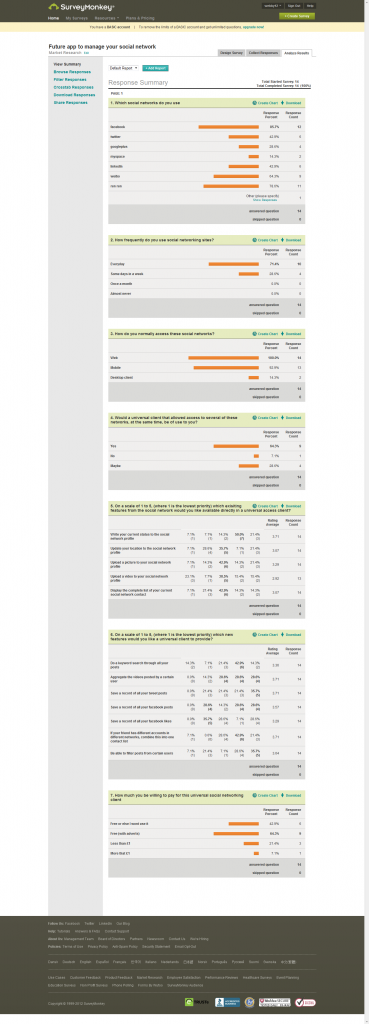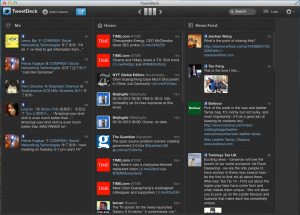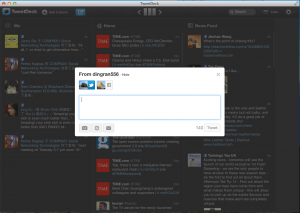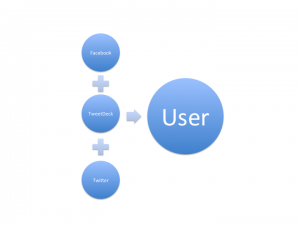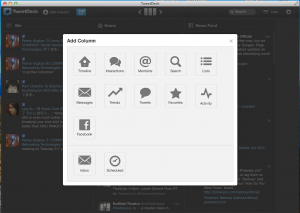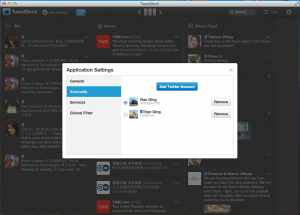Archive for May, 2012
Personal Interview with TweetDeck Developer From SUN
Posted by dingran in Relevant News & Reference on May 5, 2012
By IAIN DODSWORTH Published: 02 Jun 2011
HE may look like any other modest IT worker but Iain Dodsworth has just sold his company to Twitter – for £25 MILLION.
The 36-year-old married dad-of-two was unemployed when he set up TweetDeck less than three years ago.
His simple computer program allows users to split their PC desktop or smart phone screen into columns to keep on top of social network streams from sites such as Twitter, Facebook and MySpace – and it is now used by millions worldwide.
Iain, who lives in a modest house in Crowborough, East Sussex, is part of a new generation of British tech entrepreneurs based in Old Street, east London.
The area has been dubbed Silicon Roundabout – a nod to hi-tech innovation hotspot Silicon Valley in California, home to Apple, Google and eBay.
Here, Iain explains how to succeed in the tech business while we offer an insight into booming Silicon Roundabout.
LAST week my company, TweetDeck, was bought by California-based social network Twitter.I still find it strange saying those words — it feels like I’m in a fairy tale. But I passionately believe that anyone can do the same.There are massive opportunities for people with great ideas.I started TweetDeck just under three years ago while sitting on my sofa struggling to keep up with the overwhelming stream of information — tweets — from Twitter.TweetDeck, a multi-column application for desktop computers and smart phones, was born and its popularity has snowballed ever since. We have come a long way from our humble beginnings with just one employee and one user — me — to our current position of 15 employees and millions of users.Every day I get excited hearing how someone is using the software for a new purpose. Actor Ben Stiller uses it a lot and even rings us up asking for changes. Demi Moore and Ashton Kutcher have been filmed using it and Simon Pegg is a fan.
While I’m not saying starting a company is easy (it isn’t) or painless (it really isn’t!), there has never been a better time to be launching a company in the UK. The costs of office space and running a start-up are considerably lower than they used to be, especially for internet start-ups. You don’t need much investment to get things off the ground. Shared working space is becoming the norm, especially in areas where start-ups are swarming.We rented office space in the Silicon Roundabout from another company called Moo and there’s another suite called TechHub just next door.
These offices are packed with one and two-man companies. People stand around the kettle and talk about the problems they are having. Everyone has the same questions — how much of my company should I give up? What is the right price? It’s a very young crowd around here. There are lots of 23 and 24-year-olds — I’m quite old at 36. But trying to get your own idea off the ground has become a very real alternative career route to joining a big company and trying to work your way up. Just do it yourself instead.
I’ve not come across any problems as seen in The Social Network movie, with arguments over who invented what, but it could happen here. You’ve got lots of small companies with similar ideas sharing office space. The current Government is really supportive too — new initiatives have definitely helped to encourage entrepreneurs. David Cameron has targeted the Silicon Roundabout as the heart of a new Tech City after the London 2012 Olympics. Facebook, Google, Intel and Vodafone have all pledged to invest in the area.
It has also become socially acceptable to be an entrepreneur — you’re not dropping out of society. TV shows such as Dragons’ Den and The Apprentice are showing how “normal” people are becoming entrepreneurs in greater numbers, which in turn inspires more people to try. It is also becoming more acceptable to work at a start-up, which goes some way to solving the problems of finding and hiring talented employees. As more start-ups seek funding, this drives demand and new investors and investment funds are appearing to fill that gap.While not as mature as Silicon Valley, the new British and European start-up investment industry is here now and growing fast.
So now TweetDeck has been acquired, what’s next? As a part of Twitter, we will continue to build great products in London and be a part of its growing start-up culture. Being a part of Twitter itself is exciting because of the potential for it to become something more important than it first appeared to be. Things have changed so much for us in three years but it has been even more wonderful seeing how Twitter has quite literally changed the world in that time.
From the early years of tweeting about what someone had for breakfast, it seems unimaginable that we are now watching global events unfold, and in some cases being facilitated, on Twitter. Nobody really knew what to use Twitter for at the start. Now it has inspired the uprisings in the Middle East and brought issues with super-injunctions to light. Twitter has the potential to be the world’s main live news source. It has broken down the barrier between famous people and you and me. Who’d have thought you might get a reply back from Wayne Rooney or Rio Ferdinand?
I’m @iaindodsworth on Twitter — please feel free to tweet me.
Twitter confirms TweetDeck acquisition from Guardian
Posted by dingran in Relevant News & Reference on May 5, 2012
Josh Halliday
guardian.co.uk, Wednesday 25 May 2011 17.34 BST
Twitter on Wednesday confirmed the acquisition of the London-based startup TweetDeck in a deal thought to be worth about $40m (£25m).
The deal makes Iain Dodsworth, the 36-year-old founder of Twitter app TweetDeck, an overnight multimillionaire and an instant success story from London’s “Silicon Roundabout”.
Dodsworth, a Sheffield Hallam University-educated programmer, also confirmed the long-rumoured deal on his company’s website on Wednesday.
“I am extremely happy and proud to let you know that TweetDeck has been acquired by Twitter. We completed the deal on Tuesday and are now in the process of ‘joining the flock’,” he said.
“The past three years have been an epic journey, with many highs and lows, accompanied by the constant thrill of never really knowing what to expect next. We’ve grown from one team member and a single user, to a team of 15 and a user base of millions.”
Dodsworth said the three-year-old TweetDeck will remain on London’s Old Street, dubbed Silicon Roundabout, where many of the capital’s most enterprising internet firms are based.
More than 20 million Twitter users have downloaded TweetDeck, making it the second most-popular way to use the service, after Twitter.com. The TweetDeck app allows users to organise their Twitter feeds and their profiles on other social media networks such as Facebook in once place.
Dick Costolo, the chief executive of Twitter, described the third-party application for “power users” of the social network site as a “groundbreaking” tool.
He added: “This acquisition is an important step forward for us. TweetDeck provides brands, publishers, marketers and others with a powerful platform to track all the real-time conversations they care about. In order to support this important constituency, we will continue to invest in the TweetDeck that users know and love.
“TweetDeck is a great example of a third-party developer that designed tools for the incredibly important audience of Twitter power-users and, in turn, created value for the network as a whole. As Iain’s journey suggests, there is significant opportunity for developers who deliver insights that foster a more engaged Twitter user base.”
As the popularity of Twitter has grown – it now has more than 175 million registered users – the San Francisco-based social media company has embarked on a ruthless bid to control third-party applications such as TweetDeck.
The aggressive drive was reported to have sparked a bidding war for TweetDeck earlier this year, with the third-party apps firm UberMedia apparently offering $50m for Dodsworth’s software. UberMedia owns rival third-party apps UberTwitter, UberCurrent and Twidroyd.
Since its modest, “friends-only” launch in 2008, TweetDeck has raised about $3.5m in funding. Its investors include Betaworks, TAG, SV Angel and PROfounders.
User Requirement Research: Report and Analysis of Feedback
Posted by dingran in User Requirement Research on May 5, 2012
According to this survey, we finally got 14 people’s feedback. Due to most of our friends are Chinese, so sample are largely based on Chinese preferences.
However, it also provide us a basic information about what universal client people want to use
Question 1. Which social do you use now?
Most people reported that they were using Facebook (12), second rank is Ren Ren (11, a Chinese Facebook). Compared with Facebook, less people were using Twitter or Wei Bo (6 and 9), the result showing our sample is Facebook based user. By the way, a lot of user chose LinkIn as an option, a possible reason is that our sample based on ECS students so LinkIn were treated such important.
However, because only 14 people received this questionnaire, so the result means most people have two or three social network accounts at same time, which shows that a universal client could have a market for young social network users.
Question 2. How frequently do you use a social network web edition?
Most people replied that hey visited the social network everyday (10), while 4 people visited few times in a week. Those data shows young people really like to visit social network, as social network became part of their life.
Question 3. How do you normally access to those websites? By which way do you access to a social network?
People seems to treat web portal and mobile portal are same level important for them to access social network (14 and 13), while only 2 persons chose desktop client as their main way to access social network. It could be inferred that there is few desktop client is able to provide satisfied functions of social network so people rarely use desktop client. And this inspired us to design a prefect desktop client and web access portal to meet such need.
Question 4. Would you like to use any universal client that can access to multiple social networks at same time?
2/3 people believe they would like to try a universal client (9), while 1/3 people feel uncertain about this question (4). This indicated that though most people want to have a universal client to access social network, few people still doubt about the universal client. And we should release a attractive alpha edition to convert those people using universal client.
Question 5. From a scale as 1 to 5 (1 means the least and 5 means the most), please list the features that you want to access to a social network through universal client?
Excepted one option (upload video) has only 13 answers, all other options got fully answered. Base on the average weight, the most important feature people believed is the synchronize status or tweet to all social networks (3.71), secondary, people thought update location and access to full list of contactors were second important features for them (3.07). Update media from universal rank the least significant feature in this survey.
From this result, it can get two conclusions. First, most people want to user a universal client is to update a same information to multiple social networks. And second, our survey targets hold a strong interest to a mobile edition of universal client (update location and access full list of contractors are features that people normally used on a mobile terminal.), which reminds us to provide a web access portal or mobile edition is very important to our customers.
Question 6. From a scale as 1 to 5 (1 means the least and 5 means the most), please list the new features you wish a universal would have?
In this question, people gave various answers that made it is really complicated to analyze, however, such different shows that users really wish a universal client could have special and amazing features for them. As rank 1, aggregate video of specific user, save tweet and match friends are most wanted features that people wish to have (3.71). Filter post of certain user got 3.64 as second. The least feature people interested in is save ‘like’ from Facebook. And we will develop our client based on the list of most interesting features.
Question 7. How much would you like to pay for such universal client?
‘Free is the best thing in Internet Age’, as it goes, most people feel the client should be free to use (9 for free with advert and 6 for clearly free). However, few people, whom we believe they also chose free with advert shows that they want to pay 1 pound less to enjoy our service. So our strategy is using advertisement as main revenue, plus with premier account and function for those few people who would like to pay for our service to gain profit.
Brief Record for Meeting on 4 May, 2012
Posted by dingran in Meeting Record on May 5, 2012
Time: 14:00-16:00, 4th May 2012
Attendees:
Bin Ren
Bai Jialiang
Ding Ran
Petros Kagkas
Brief Record:
At beginning of this meeting, Bin Ren, Bai Jialiang and Ding Ran first discuss some technical issues on developing a prototype, mainly focus on the programming language and how could we access user profile from social networks without login page shown.
Then we four talked the working schedule and division about future work. A initial decision was made as Ding Ran and Petros Kagkas would be in charge of documenting, while Bin Ren and Bai Jialiang will work on developing the prototype. We also decided to meet again on next Wednesday and check our progress at that time.
Research Case: TweetDeck
Posted by dingran in Research Case on May 3, 2012
1. Background Introduction
The original TweetDeck is an application developed by Iain Dodsworth, A British programmer from 2009 to 2011. In previous editions, it allows user access multiple accounts from Facebook, Twitter, LinkedIn, Google Buzz and MySpace by different columns. It was the most popular Twitter application with Market share 23% on June 2009 [1]. After a potential threat happened that another company showed a strong interest on TweetDeck and willing to offer $25-$30 million to buy TweetDeck, Twitter purchased TweetDeck possible in double price finally [2]. After this acquisition, TweetDeck changed from an Adobe AIR programme into OS native applications. However, after TweetDeck became a part of Twitter, some features of TweetDeck were removed such as Tweet more than 140 words. [3]
2. Features of TweetDeck
After download and installed TweetDeck, user first needs to register a TweetDeck account.
Because all update information is send through TweetDeck, so user also needs to give TweetDeck authority from relevant social networks.
After all were set down, user will first see the main page of TweetDeck, it is consisted of three columns while user can shift those columns to left and right.
Each column could display things like twitter home, Facebook @me, Facebook News feed, or favorite tweet etc. When user wants to post or update something to Twitter or Facebook, a pop-window will be displayed and user can choose options of social networks where the information should go.
There are following features supported by TweetDeck:
1. Post tweet and statement in text to both Facebook and Twitter at once.
2. View the information from Twitter (Trends, Titter Home, Lists, Mentioned and Message) and Facebook (Newsfeed and Notification).
3. User can define the interface by adding or removing column from the interface. Each column presents the content from Twitter or Facebook.
4. User could have multiple Twitter accounts online at same time.
3. Advantages of TweetDeck
l Universal:Although today people usually have several accounts on different social networks, there are few universal clients for such need. TweetDeck earned such high market share owe to it integrated other social networks, which save a lot of time for user to manage accounts. To social networks, especially for twitter, since information on Twitter is frequently updated, if user could easily share information from Twitter to other social networks, then it would help user stay with Twitter longer, and it also increases the frequency/chance that a user visit other social network.
l General Access: The original TweetDeck is developed under Adobe Air, so user just needs to log in it as Web Application without OS problems. After purchased by Twitter, TweetDeck also provides OS native application and mobile edition on iOS and Android system.
l Easy to manage: TweetDeck gives user a straightforward way to view tweet and information from Facebook. By switching to different columns, user can easily browse different catalogues of information. To send a new tweet or statement, user just need to click the button on top left and select relevant social network.
4. Disadvantages of TweetDeck
l Network Barriers: One of the most difficult challenges for an universal client is that different social networks would apply various APIs for third party to transmit data. For instance, Twitter regulated a picture should be expressed as a ‘short link’ in a tweet, however, on Facebook it should be directly uploaded to Facebook with statement. When user wants to share a picture to both Twitter and Facebook through TweetDeck, it usually causes a problem as update failure. And due to different structure between Twitter and Facebook (information flow-based and person-based), TweetDeck offered more options of viewing for Twitter than Facebook.
l Monopoly: After Twitter purchased TweetDeck. TweetDeck began to incline to twitter contents. Some attractive features including deck.ly, a feature allows user send tweet more than 140 words, were removed by Twitter. Meanwhile, TweetDeck gives more options on Twitter information than other social network. Compared with Twitter, there are only two information flows are provided to user: News Feed and Notification.
What’s more, a user is able to add multiple accounts on Twitter but only one account on Facebook.
Those leads user believe that TweetDeck is no longer a universal client but a Twitter client now.
l Function Limit: Because each social network has its unique functions, a universal may not be able to present them all in common panel and interface. In TweetDeck, it supports most operations on Twitter while a lot of operations to Facebook are accomplished by redirecting to Facebook webpage. By our interview, some users also stated that they would like to use a specific client rather than a universal client to fully enjoy a social network.
5. Summary
TweetDeck is a very good example about how a universal client achieved success from social network users. Even though the application started as an individual developed programme without any profit, it finally attracted Twitter’s attention and earned both cash and stock from Twitter Company to its developer. However, such deal sacrificed the further improving space for TweetDeck. And we should find some other profit point to keep our application having a good future.
Reference:
1. An In-Depth Look Inside the Twitter World, http://www.sysomos.com/insidetwitter/
2. Twitter confirms TweetDeck acquisition http://www.guardian.co.uk/technology/2011/may/25/twitter-confirms-tweetdeck-acquisition?INTCMP=SRCH
3. TweetDeck kills off Deck.ly’s long-form integration with an all-platforms update http://thenextweb.com/apps/2011/09/15/tweetdeck-kills-off-deck-lys-long-form-integration-with-an-all-platforms-update/
Initial Proposal for uniformed client via multiple social networks
Posted by dingran in Project Proposal on May 2, 2012
Goal
Design and develop a PC client that helps user could simply access and update information between different social networks by one uniformed client.
Develop Team
Webbers
Features
1. Retrieve data and information from social networks and display it by timeline
The client uses APIs provided by social networks, with user’s authentication (as account ID and password), to access, retrieve data and information from social networks. After those data and information are received, GUI will generate a form listing all data by different catalogues via timeline.
2. Update one message to all selected social networks
Sometimes, user would like to update one statement or notice to multiple social networks. For instance, a user may get some impressions about an excellent concert, and he tends to share this feeling with other friends in MySpace, Twitter and Facebook. This client will help user update one statement or text to all social networks at same time.
3. Search and Sort information stored in local database
The client keeps all data it received from social networks and stores it in local database. It will try to analyse keywords of those data and establish an index of data so user can search those records by keywords, time or location (if they do have geographical tags). And it is also available for users sorting data by different order (timeline, location or publisher).
4. Measure the close degree between one and his/her friends (Temporal )
The client can make some simple statistics as how many times a friend retweets you tweet, replies your statement or comments on your photo. This function aims giving to the user a direct way to find who is the most active person in his /her social network.
Technical Details
Developing language: Java and Java 2 EE, with social network APIs.
Presentation: The content will be embedded as a web page (in Html format) in Java programme.
Edition: First edition will illustrate some basic function as a prototype, further edition may fulfill some advanced features.
Challenges
1. Use and introduce APIs of different social network systems
2. Present the information in a user-friend way
3. Mange and search database from different source
4. Design an available statistics system for social networks
